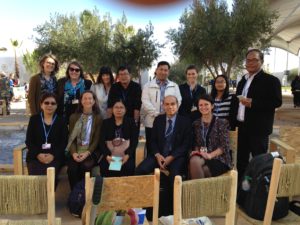Loss and Damage at COP22

The entrance to COP22 venue in Marrakech, Morocco.
By Jonas Reagan
Every year, the Conference of the Parties (COP) to the United Nations Framework Convention on Climate Change (UNFCCC) convenes to address pressing climate-change concerns, develop strategies to effectively reduce discernible consequences, while building on previous agreements that have entered into force. This year, COP22 met in Marrakech, Morocco. After the pivotal entry into force of the Paris Agreement, the international community was eager to see what the impacts might be on the negotiations. One issue that has emerged, which is a major diversion from previous COPs is that of Loss and Damage (L&D).
Generally speaking, Loss and Damage refers to the adverse effects of climate change that people cannot adapt to, such as irreversible sea level rise, extreme weather events, salinization of farmland, desertification, heatwaves, loss of biodiversity, and cultural heritage loss. For much of UNFCCC history, Loss and Damage had been treated as a small aspect of adaptation. It includes the permanent loss of land, culture, and human life and will escalate existing tensions over increasingly scarce resources. This tension will ultimately incite conflict in many parts of the world. In some places, the loss of habitable land is forcing individuals and families to leave their country, threatening their sovereignty, and some countries are entirely submerged as a result of increasing sea levels. Loss and Damage encompasses the economic and non-economic consequences disproportionately affecting developing nations that can even threaten their sovereignty. The parties only last year recognized Loss and Damage to be a substantial and independent consideration apart from adaptation in Article 8 of the Paris Agreement, but it was unclear as to the path L&D progress would take at COP22.
At COP22, groups known as the Subsidiary Bodies met separately to address L&D agenda items. They considered the future five-year work plan of the Warsaw International Mechanisms (WIM), established at COP19 and also addressed the terms of reference for the review of the WIM. Both issues are critical to further the parties’ understanding of L&D and how best to minimize the unstoppable impacts. Since there is a substantial divide in prioritizing this issue between developing countries and developed countries, addressing these agenda items became highly contentious.

The Vermont Law School team supported the
delegation from Myanmar at COP22.
Photos courtesy of Trach Bach, Professor of Vermont
Law School delegation to COP22.
After many late-night negotiations, the groups came to a surprising agreement on both issues related to the WIM for L&D associated with climate change impacts in their 45th sessions.
The first issue established the indicative framework for the WIM’s five-year rolling work-plan to include a strategic work stream to guide the WIM in enhancing action and support through finance, technology, and capacity building. This step is integral to understanding L&D and providing the COP with a range of strategic activities as it goes beyond the initial two-year work-plan. This decision also extends an input invitation to, not just parties, but also “relevant organizations.” However, this decision alone falls short of the Subsidiary Bodies’ directive. In one decision, the COP called for a review of the WIM at COP22. This L&D aspect was the most contentious debate among the parties. Because the COP accepted the draft conclusions, the COP will periodically review the WIM no more than five years apart with the next review to be in 2019. The terms of reference for each review will be determined no later than six months before the review.
While the progress the parties made at COP22 is substantial, there is a long way to go. Researchers need to conduct additional inquiries into the relative efficiency of L&D action plans, but people are currently suffering from these extreme weather events and some have already lost sovereignty due to sea level rise. The risks of L&D are exacerbated through current country inaction. By countries not adopting aggressive mitigation targets, they are not only increasing the widespread need for adaptation, but they are worsening the situation by exponentially raising the risk of more frequent extreme weather events and more extensive slow onset events. The window to act is closing, and people are caught in the middle.
Jonas Reagan is a JD candidate at Vermont Law School.








Leave a Reply